The dishes that tell the story of Ukraine’s multicultural port city.
Odessa—Ukraine’s third most populous city, on the northwestern shore of the Black Sea—has had a relatively short but eventful history. It blossomed from a small Ottoman settlement to a fabulously wealthy and cosmopolitan port city, but from the 19th century onwards, plague, pogroms, war, and revolution would test its spirit. Still, the city’s humor, cosmopolitanism, and diverse cuisine endured.
Once an ancient Greek settlement, the Odessa region was later ruled by various nomadic tribes and eventually the Ottoman Empire. Empress of Russia Catherine the Great founded the city by decree in 1794, and called for people to help build the new port, promising religious freedom and economic opportunity. Eastern European craftsmen, wealthy Venetian and Genoese traders, and French and Greek sailors came in droves to make their fortunes. Odessa also became home to one of Europe’s largest Jewish populations and a center of Ukrainian Jewish life.
In a short time, the grain trade and Odessa’s free port status transformed a small fishing outpost into a wealthy and culturally diverse city. But this golden age didn’t last. In the mid-1800s, Odessa lost much of the grain trade that made it prosperous. A series of anti-Jewish pogroms started in the 19th century. The 20th century brought famine, war, and revolution, including the Bolshevik Revolution in 1917, and in the early 1930s, the Holodomor—a man-made famine implemented by the Soviet government—which killed millions of Ukrainians. Then came World War II and the German occupation. Later, the shocks of the Soviet Union’s collapse brought a decade-plus of economic disaster in the 1990s.
My family left Odessa for the U.S. in 1995 on a refugee visa. I returned as a visitor, always ready to dive into my favorite Odessan cuisine. Here are some of the city’s signature dishes.
Plov with Black Sea mussels
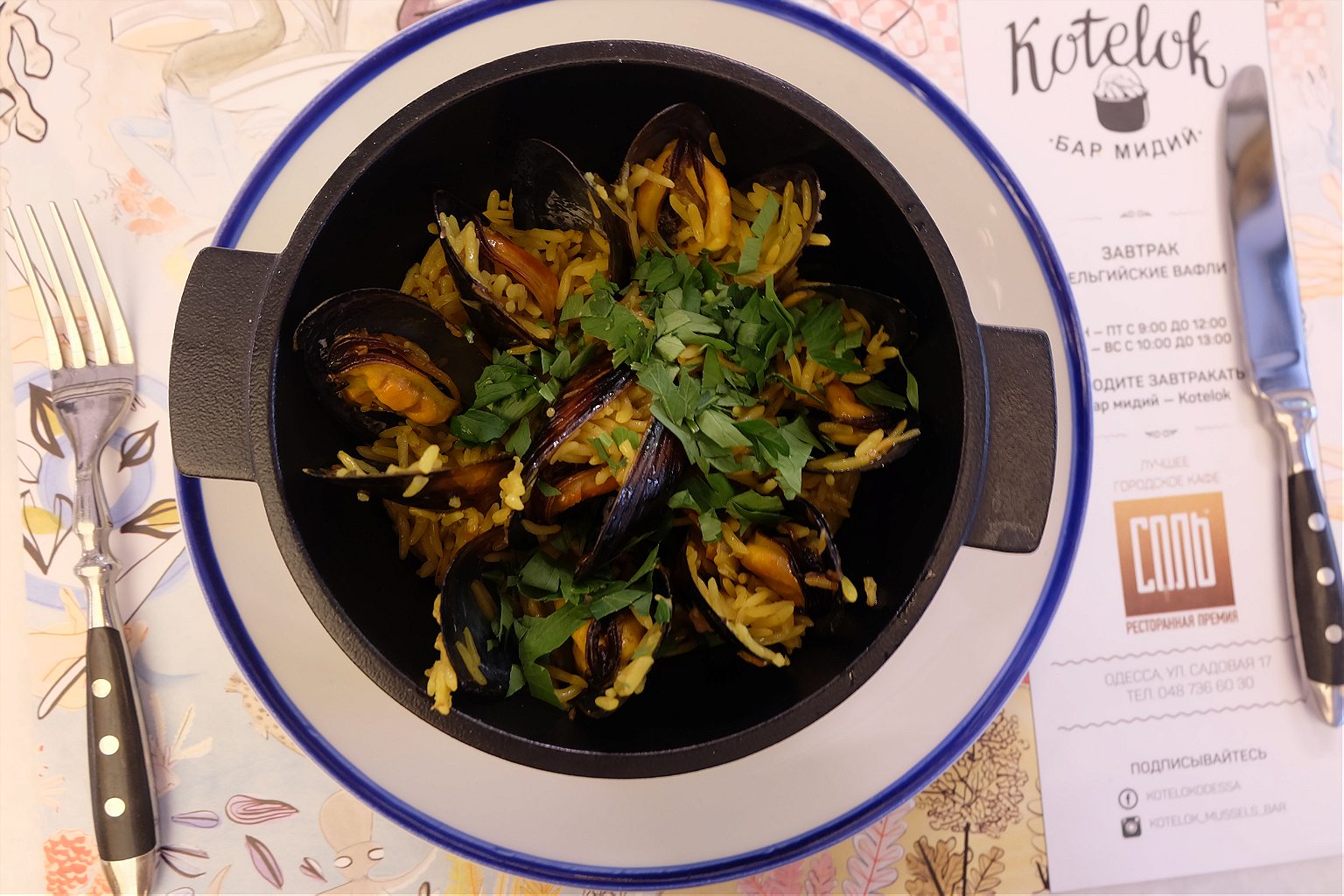
Roughly one thousand years ago, nomadic tribes from the Ukrainian Steppe settled where Odessa now lies. As nomads, they roamed the Steppe freely, never staying in one place long. In the 13th century, the Mongolian Golden Horde conquered the Kievan-Rus, a loose confederation of East Slavic and Finnic people which became the foundation for modern Russia and Ukraine. These conquerors are believed to have brought plov, rice cooked in seasoned broth, also known as pilaf. Though classic plov is prepared with lamb or horse meat, over the years Odessa has put its own spin on the dish, soaking the rice with mussels to give it a rich, briny flavor. Some locals fish for the mussels near the shore and prepare plov on the beach; others go to Kotelok in the city center on 17 Sadova Street for a small cast-iron pan.
Brinza
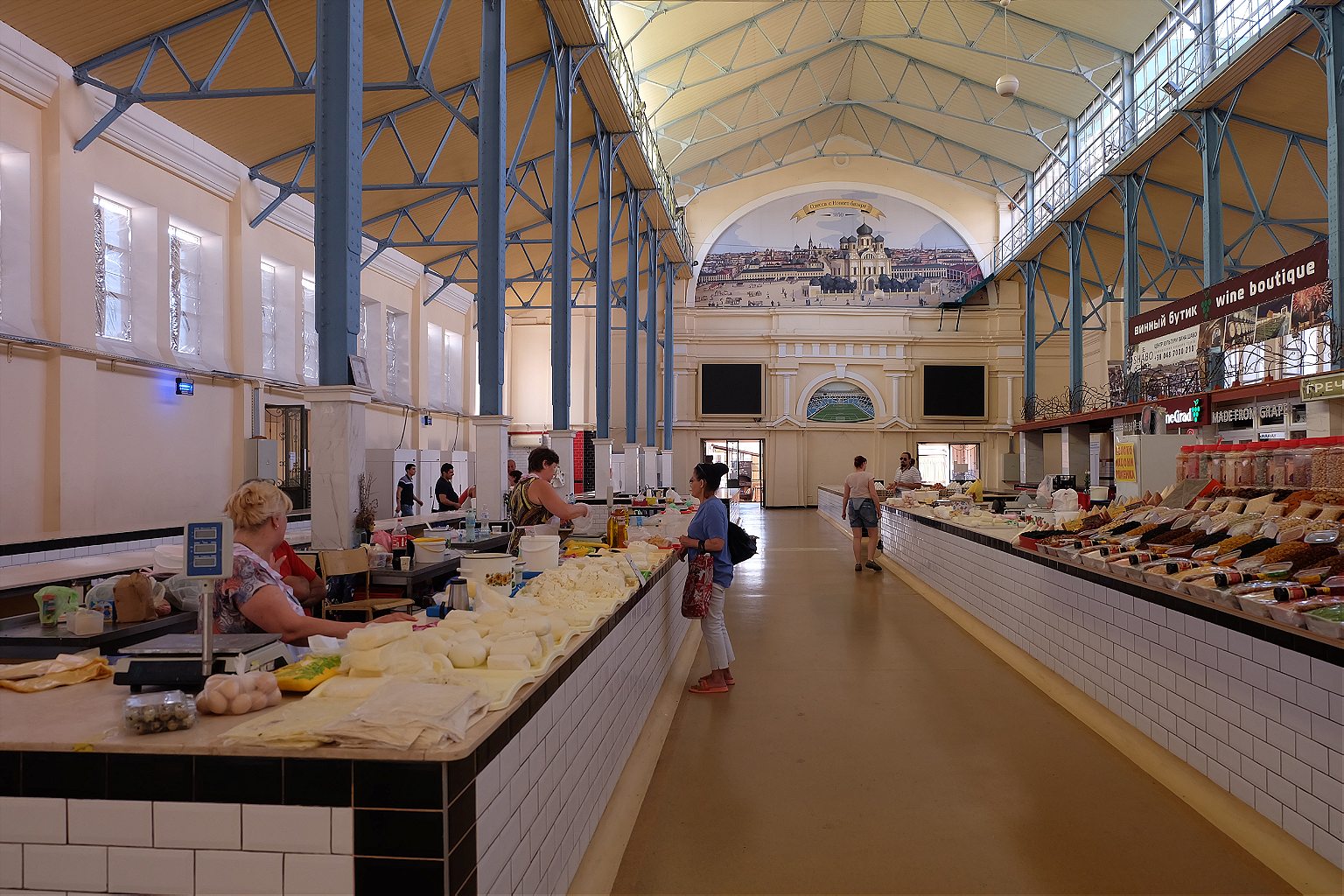
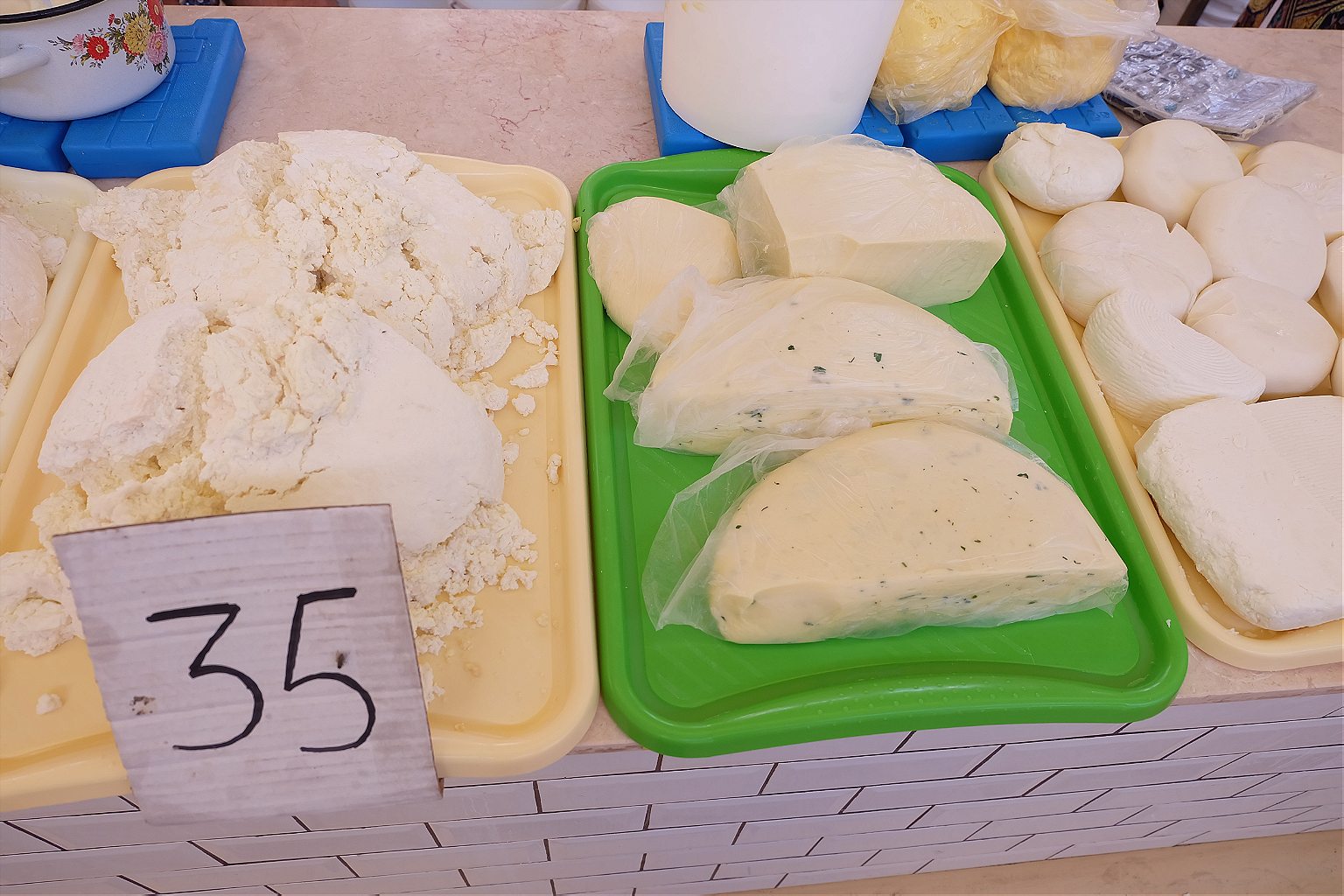
Greeks have long had a presence in Odessa. Long before Catherine the Great established the city in 1794, there had been an ancient Greek settlement in that location, around the 6th century B.C. After Odessa was founded, Greek merchants and shipbuilders came to the city and formed a prosperous business class. It was also in Odessa that the leaders of the Greek independence movement, Nikolaos Skoufas, Manolis Xanthos, and Athanasios Tsakalov, founded the secret society—the Filiki Eteria (Society of Friends)—that helped spark Greece’s War of Independence (1821–30) from the Ottoman Empire.
The Greek influence on Odessa’s cuisine is subtle, but powerful. Many Greek recipes were adapted with ingredients native to the region, and the Greek influence is evident in dishes using fragrant herbs such as rosemary, goat cheese in the food markets, and courtyards overgrown with grape vines. The Greeks also introduced grape-growing to the region. Seasonal grapes and goat cheeses abound in Odessa’s bazaars, many of which have whole wings devoted to brinza, a local goat cheese, and the salty, crumbly varieties are similar to Greek feta. Ask the babushka behind the counter at Novi’i Rinok in the city center on Torhova Street—they have it all.
Forschmack
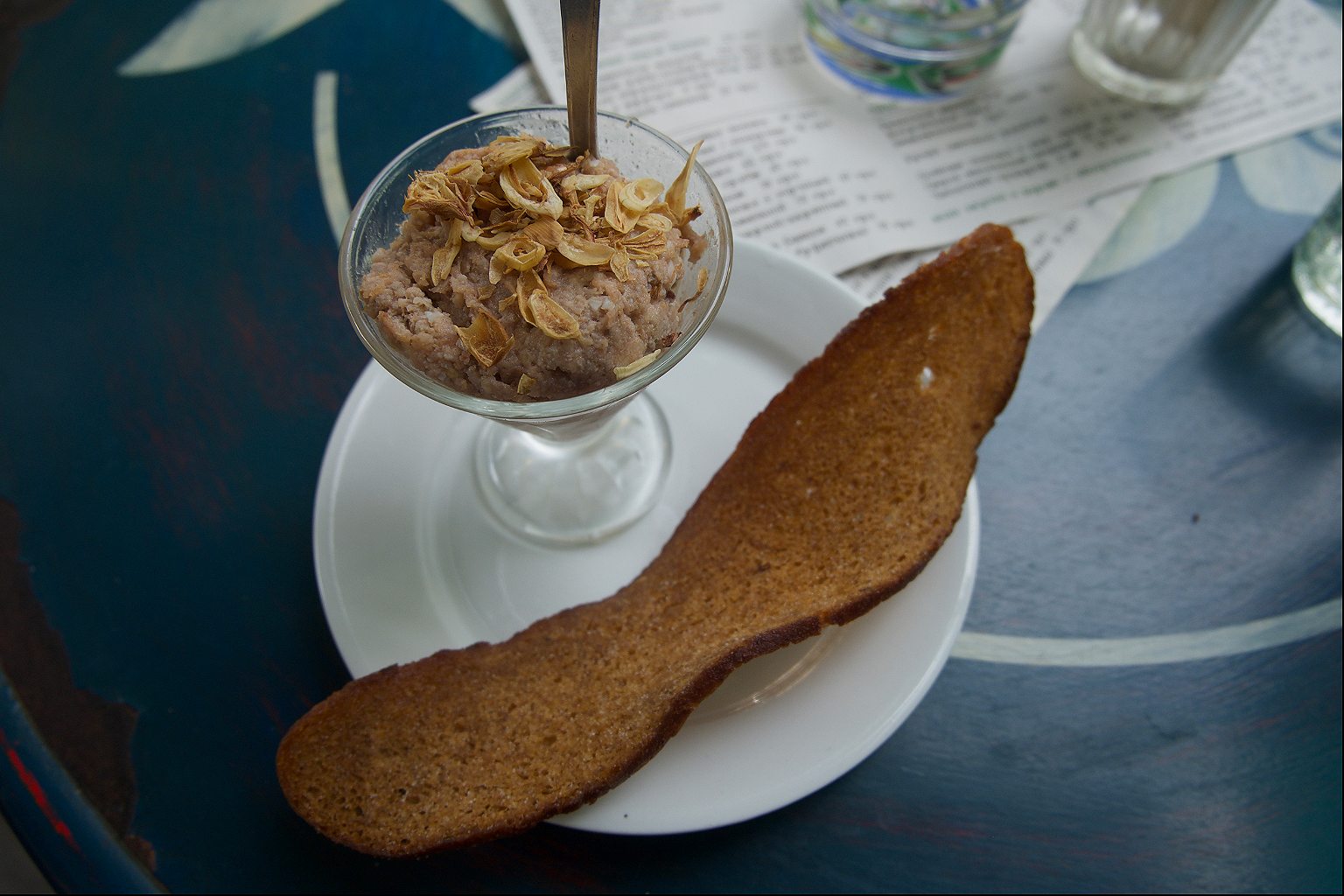
Odessa’s once thriving Jewish community, which made up a quarter of the city’s population before World War II, made an enormous impact on the city. Odessa’s Jewish heritage can be found in its renowned humor, its vernacular, its blend of Yiddish and Russian languages, in literary classics such as Isaac Babel’s “Odessa Tales,” and of course, its cuisine.
In Imperial Russia, with some exceptions, Jews were permitted to live only in the Pale of Settlement (a region of varying borders that existed from 1791 to 1917). This included the future city of Odessa and the Black Sea territory that Russia annexed from Turkey. Many Jewish settlers became grain traders that competed successfully with the Greek and Italian merchants, and, thanks to the city’s liberal bent, integrated easily.
One of many Jewish dishes that has been given a distinctly Odessan touch is forschmack, a fish (usually herring) pâté spread over rye bread, originating in Eastern Europe. The fish is often soaked in milk and blended with sour apples and walnuts. Tylka, in the city center located a block away from Preobrazhensky Cathedral at 46 Koblevskaya Street, makes some of the best in town.
Odessa-Style Bouillabaisse
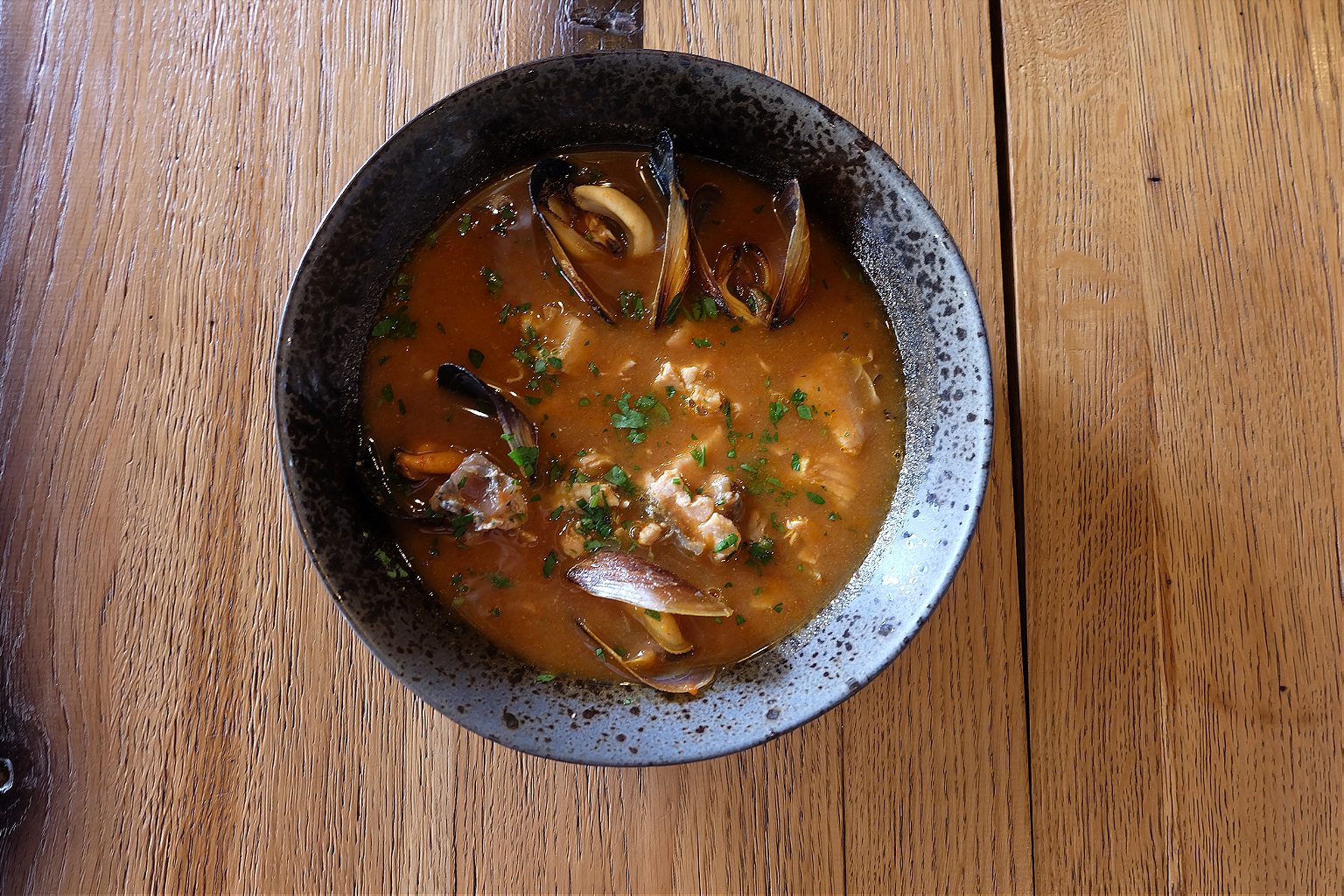
Armand-Emmanuel du Plessis, Duke de Richelieu, was a French nobleman and one of Odessa’s most illustrious leaders. Fleeing an arranged marriage, he volunteered for the Russian Army during the reign of Tsar Alexander I. As a reward for his loyal service, Alexander made Richelieu Governor of Odessa in 1803. When he had to choose between fighting Napoleon or staying in Odessa to help it recover from the Black Death, which devastated the city in 1812 and 1813, Richelieu chose to stay with the city he loved. Between 1803-1814, Richelieu helped transform Odessa from a town of 7,000 into a commercial hub.
The city’s French influence was not limited to the aristocracy. Sailors from Marseille, Sicily, and other Mediterranean ports brought a seafood broth that has become another Odessa treat. Bouillabaisse, said to originate in Marseille, is typically made from leftover scraps from the fish market—fish, mussels, and prawns that went unsold. Russian ukha fish soup is found throughout Eastern Europe, and in Odessa, local chefs infuse their fish stew with provençal seasonings. When walking down the bustling Derybasivska Street, stop by Ryba v Ogne (translation: Fish on Fire) on Krasny Ln. 1, for the hearty broth.
Black Sea Mussels in White Wine, Cream, and Herbs
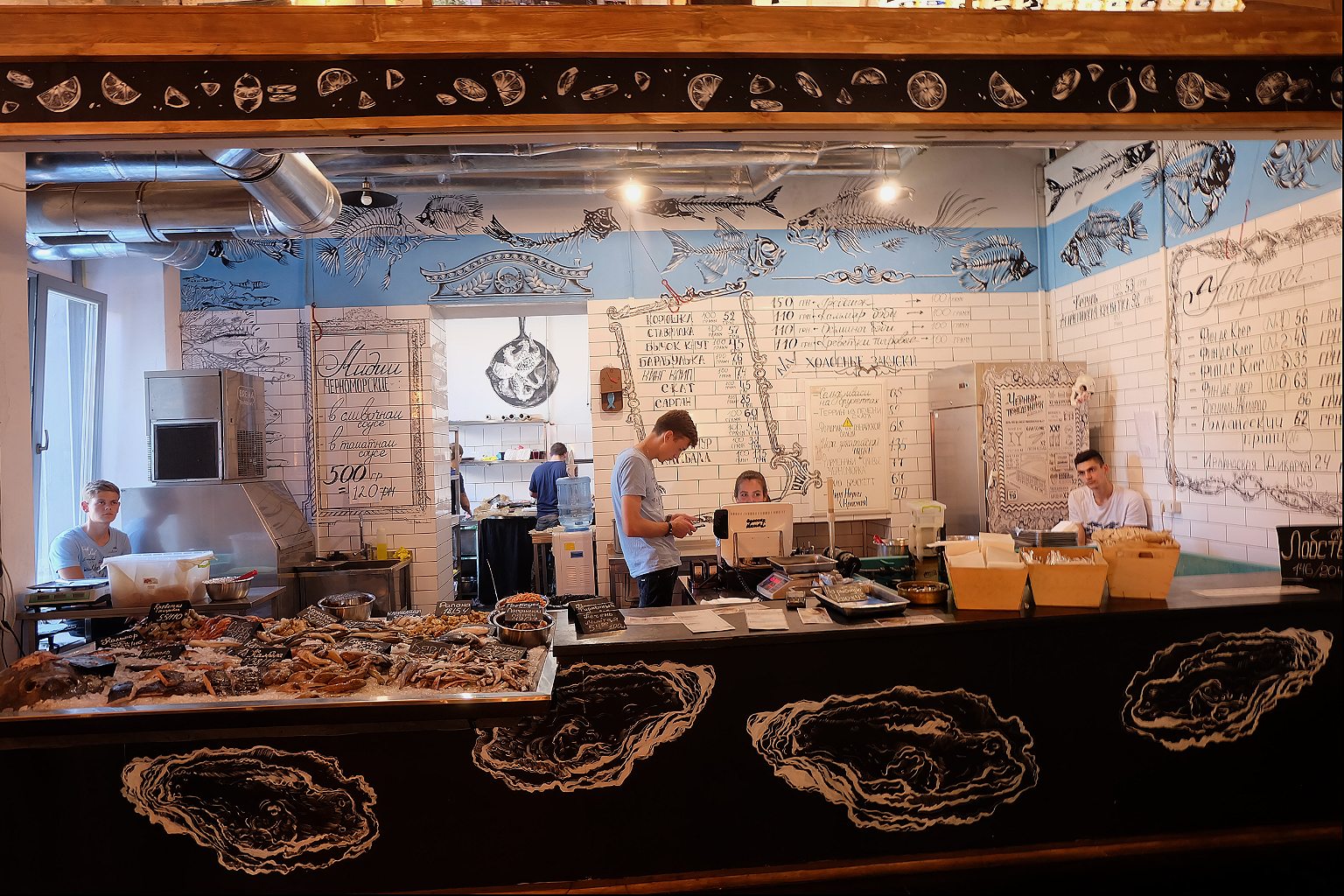

In the late 18th century when Odessa was founded, the Russian aristocracy was obsessed with all things French. Tolstoy’s “War and Peace” is peppered with French passages to show how removed the ruling class was from its subjects. In Odessa, the French influence is present in the Rococo-style architecture of local landmarks such as the Passage and Palais Royale. Though many Odessits enjoy Russo-French classics such as Olivier Salad and Napoleon cake, simpler French-inspired dishes, such as Black Sea mussels made with white wine, cream, and herb sauce are also popular, and look suspiciously similar to the ones found in coastal France. Also, as in France, they are served with rustic bread to mop it up. Get yours at the City Food Market on Rishelyevskaya Street, or Brothers Grill on Derybasivska Street.
Bichki Bullfish
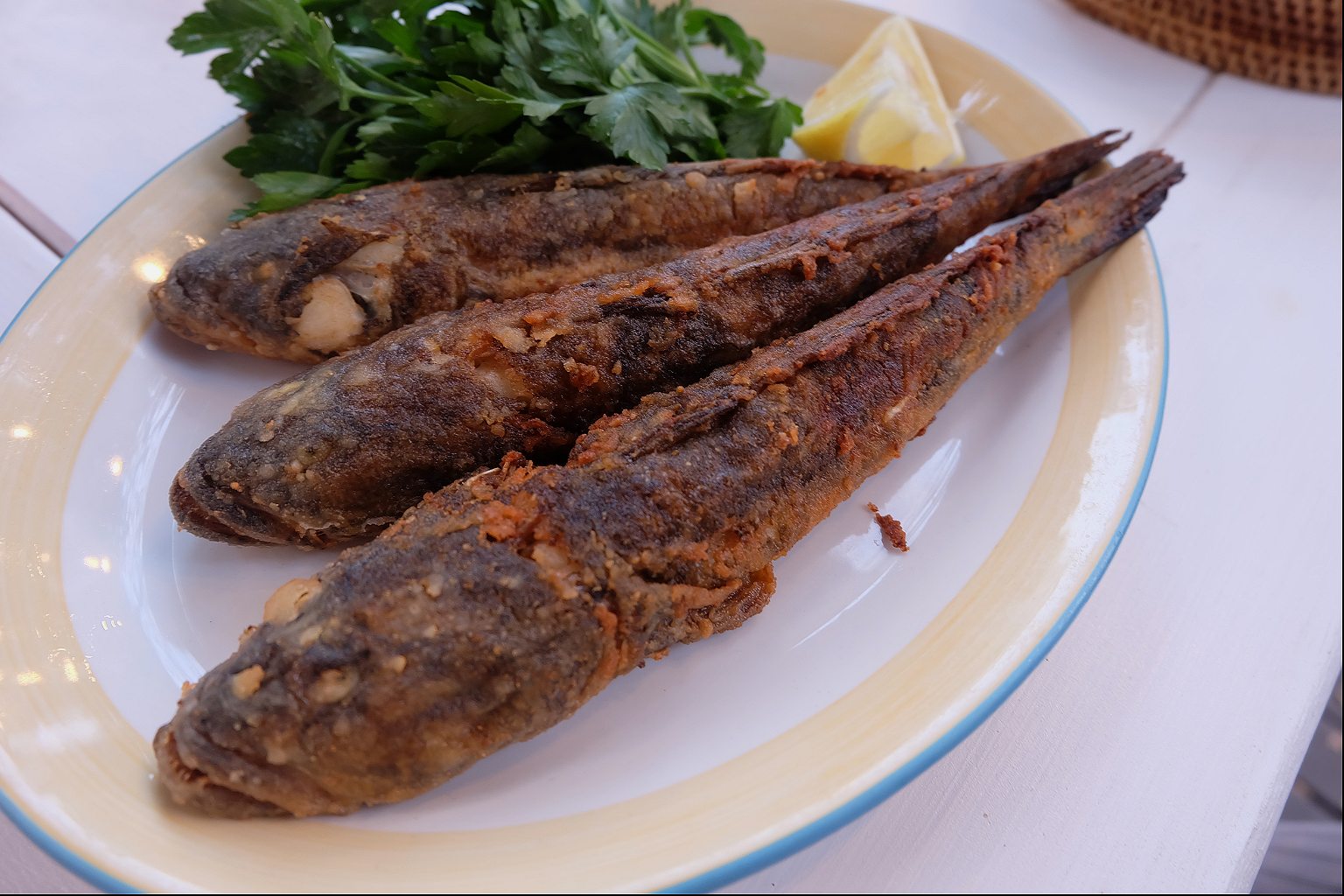
As the second-largest port in the Russian Empire, Odessa attracted skilled sailors from Greece and shipping merchants from Genoa and Venice. Bichki are plentiful in this part of the Black Sea, and sailors would often cook these delicate, flaky fish right on the docks. Small stavridas (jack mackerels) that can be eaten whole, spine and all, and tiny, deep-fried tsa-tsas (European sprat) are also popular, favored for their sweet flesh, small bones, and meaty cheeks. For bichki, head to the City Food Market for that day’s catch, or if you’re in the mood for Soviet nostalgia, order yours with a cold beer at the picturesque Dacha Restaurant on French Boulevard, a leafy cobbled street that’s also home to Henri Roederer’s Odessa Champagne Factory.
Khinkali
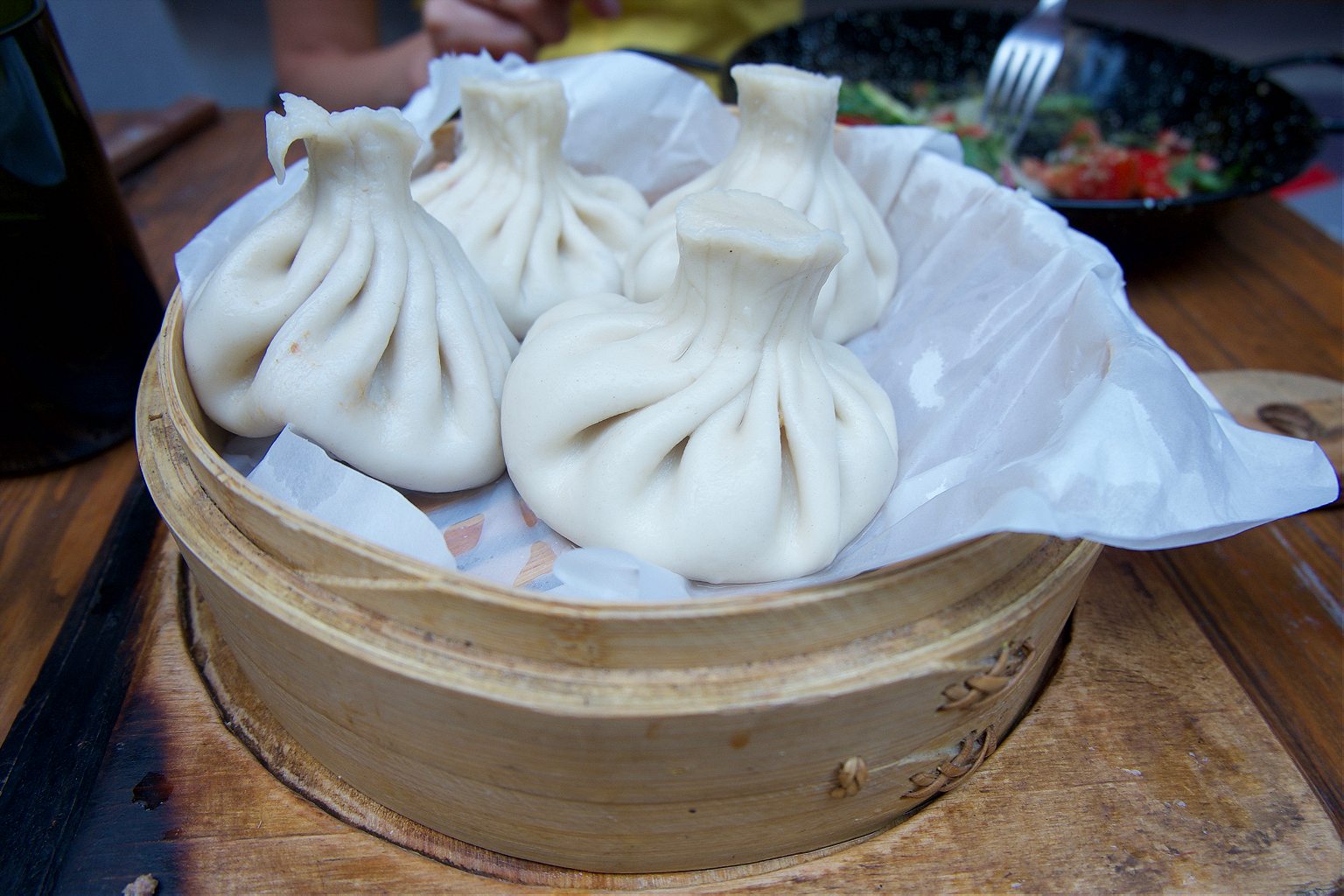
Odessa shares a shoreline, trade, and more recently, a former president with Georgia, its Caucasus neighbor to the east. Although Ukraine and Georgia signed a treaty to establish diplomatic ties in 1918, traders from the region have been coming to Odessa’s markets for much longer. As sweet Georgian fruit appeared in the bazaars, so did meat-and-cheese-filled pastries. Though Odessa’s Georgian population was never very large, their influence is felt on cafe and restaurant menus throughout the city. The famous khinkali soup dumplings are typically filled with meat, herbs, and sometimes cheese and mushrooms. Today, most Odessits like to eat khinkali outdoors with a glass of Georgian wine. At the local markets, you’ll also find rolls of Georgian sulguni cheese and fresh-from-the-oven khachapuri bread. Givi to Me serves an excellent khinkali right next door to the City Food Market on Rishelyevskaya Street.
Kebab
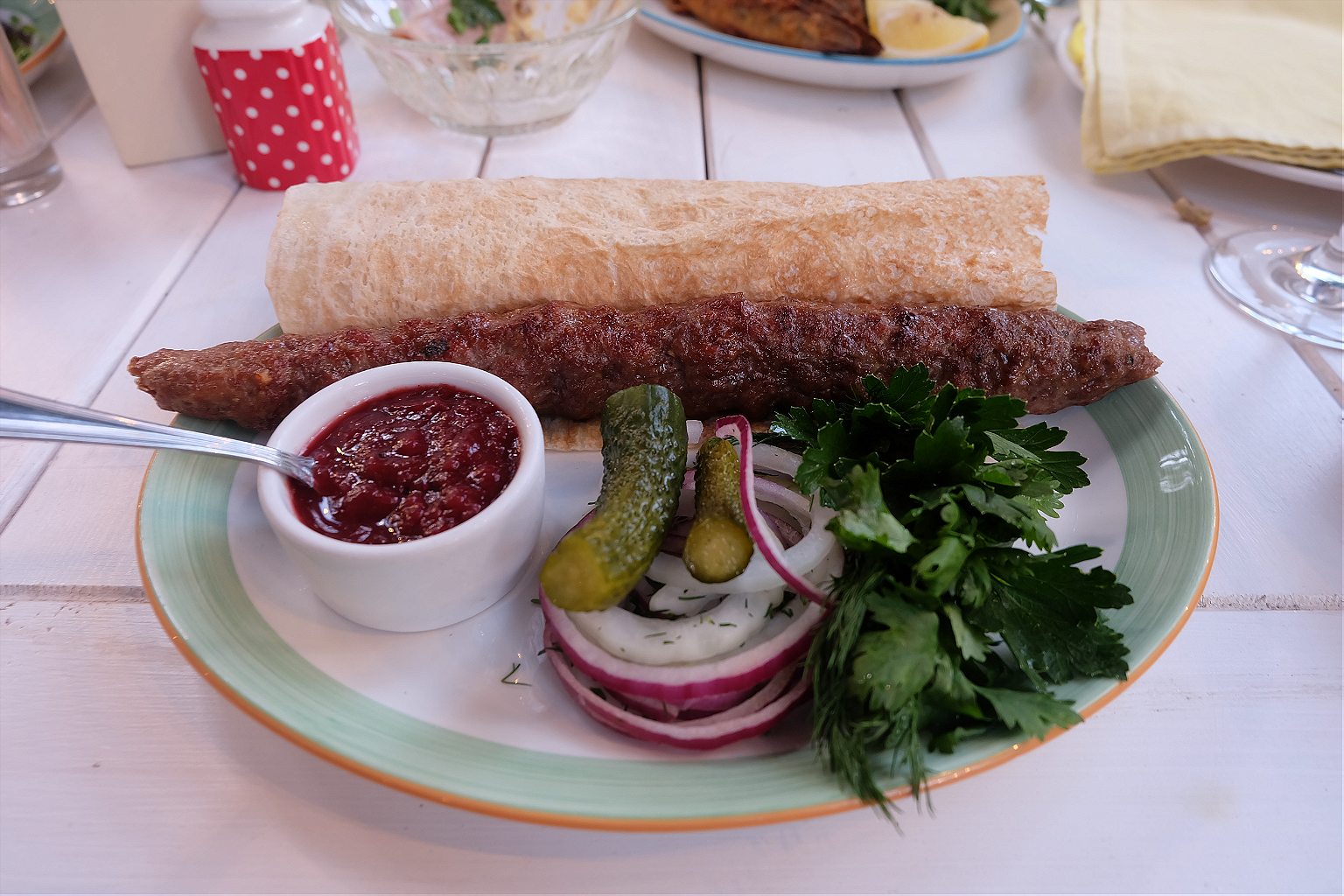
From the 14th to the mid-18th century, there were around seventy Armenian communities in Ukraine, from Kiev to Odessa. The Armenian migration to Ukraine started much earlier, around the 11th century. The late 1980s and early 1990s were a difficult time for post-Soviet states, but particularly the countries of the Caucasus. Many Armenians fled the political and economic fallout from the collapse of the Soviet Union. The Nagorno-Karabakh War, which began in the 1980s and lasted until 1994, and triggered another migration. Many came to Odessa and started businesses, built churches, and opened restaurants. A 2001 census put the Armenian community in Odessa at 7,400, but despite the small number, Armenian food and culture have made a significant mark on the city.
Many local restaurants serve Armenian-style shashlik—made with whole cubes of marinated meat with onions and fresh herbs. Dacha Restaurant makes a tasty shashlik with lavash flatbread. Grab a table outdoors and soak in the neo-Soviet atmosphere and the Edith Piaf soundtrack. If you’re staying closer to the Arcadia tourist complex, stop by Ararat Restaurant for a mixture of traditional Armenian and Odessan dishes.
Mamaliga
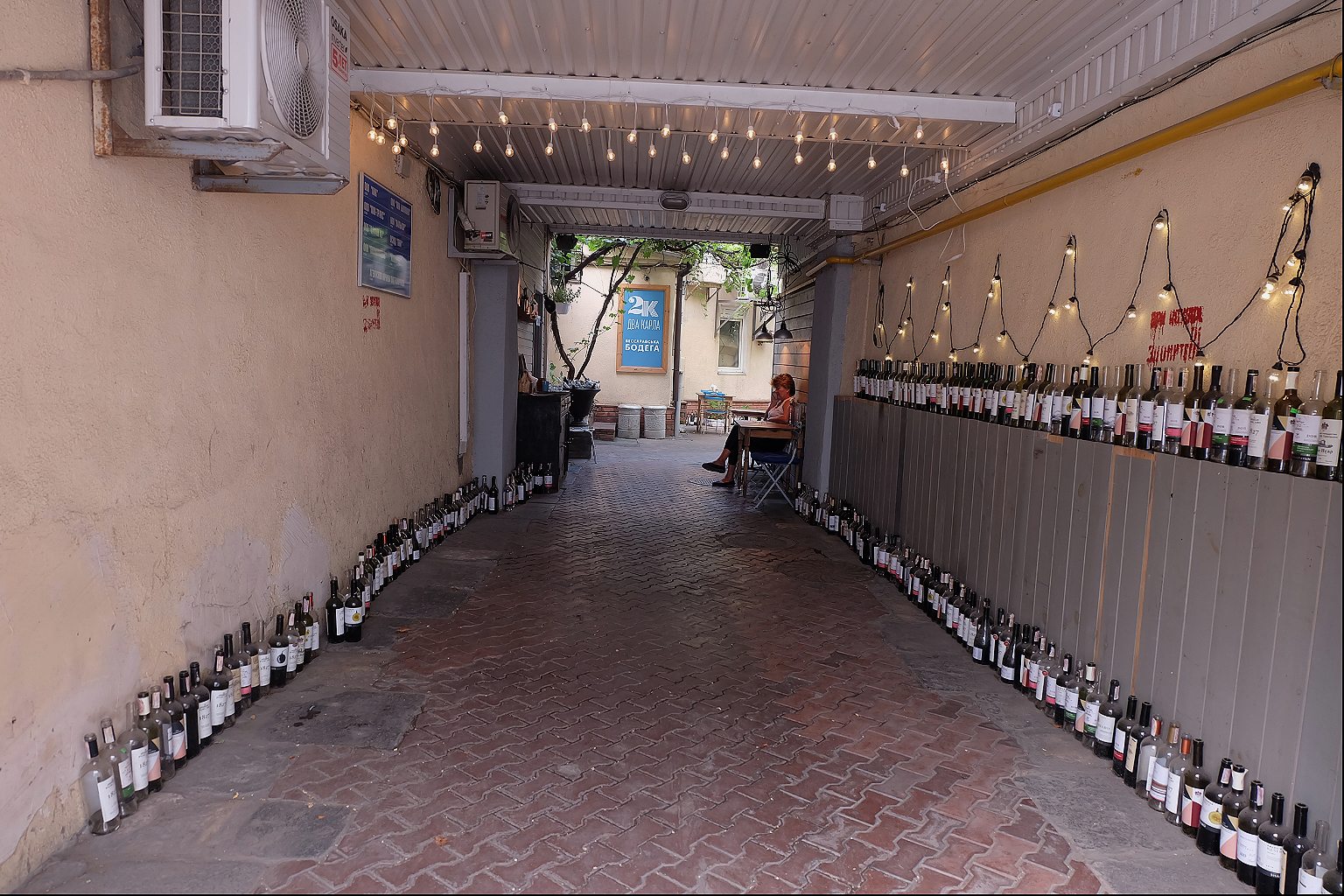

There’s a neighborhood named for Odessa’s Moldovan community (Moldovanka) for good reason. Moldova was once part of a region known as Bessarabia, bound by the Prut river to the west and the Dniester river to the east. The Bessarabian presence on the Black Sea dates back to the 7th century. In 1991, Bessarabia was divided between Ukraine and Moldova. Bessarabians aren’t a single ethnic group, but are Ukrainians, Moldovans, and Bulgarians who lived under a Russo-Turkic culture, with its related cuisine. One of the most quintessentially Bessarabian dishes is mamaliga, somewhat of a sister to Italian polenta. In Odessa, Mamaliga is seasoned with garlic sauce and dipped into sour cream and brinza. A ten-minute walk from the hustle and bustle of Derybasivska Street in the center, Bodega 2 Karla on 32 H’retska Street (Greek Street) serves a good mamaliga.
Rachki and Rapani (Black Sea Region)
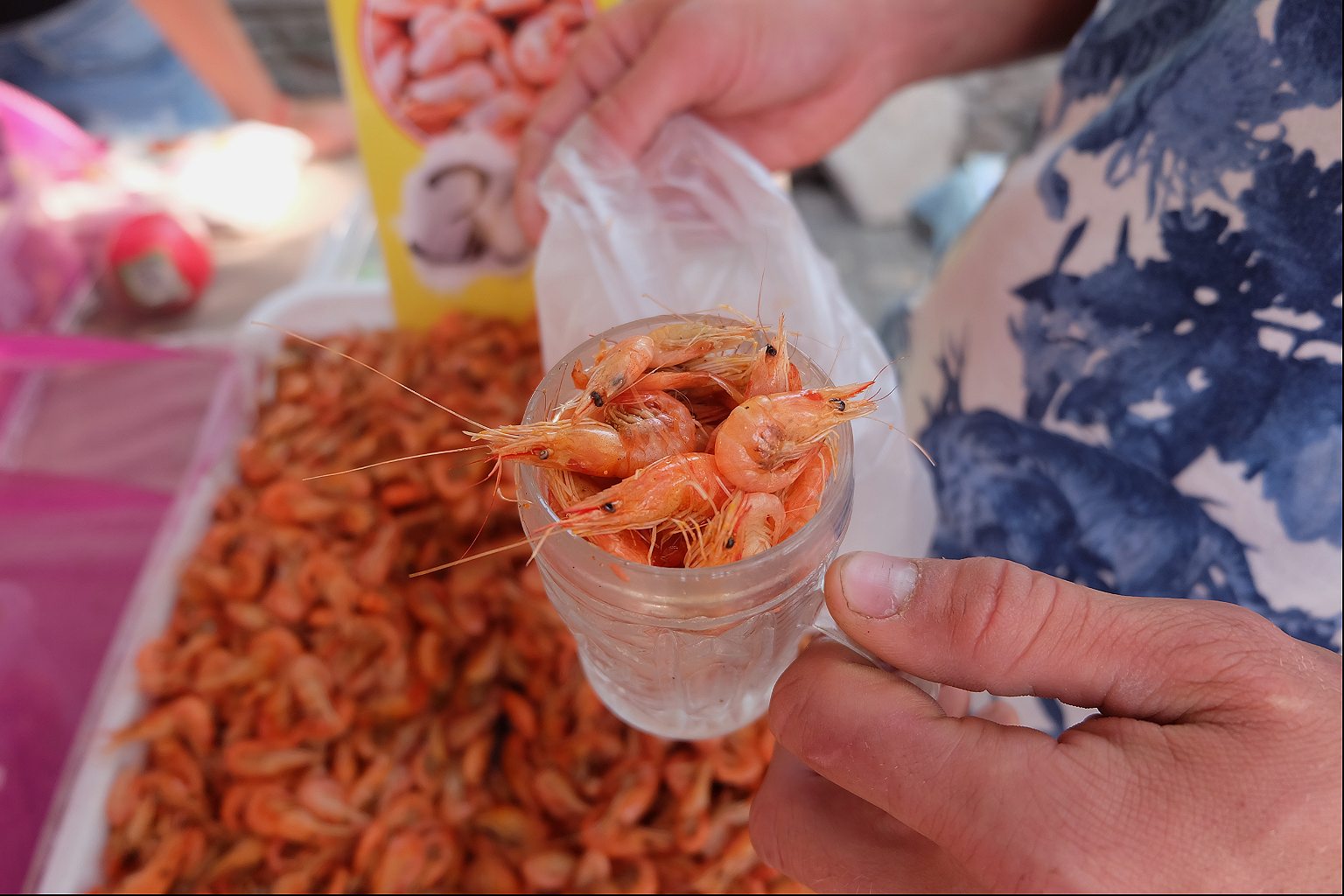

It is a most Odessan tradition to go for a sunrise swim in the Black Sea. Along the waterfront of Langeron Beach, you will see men with bags of small conch-like shells slung over their shoulders: rapani. Locals serve these with cream, herbs, and onions. There are no official records, but the cream and herbs could be another French influence. Another beloved catch are tiny, briny Black Sea prawns called rachki. The best way to get rachki is to buy them from a babushka on the way to the beach. Look out for their tables, piled with rachki right at the entrance to Langeron or Otrada beaches. For a good plate of rapani, stop by Grill Brothers on 17 Derybasivska Street.